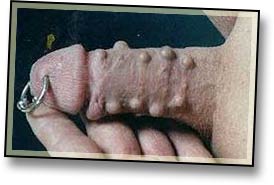Implant Subdermal Shifting
Smooth-surfaced placed under the skin can shift during healing into a location other than intended, leaving them crooked (a condition nearly impossible to correct).In general, there are three phases of shifting. Some shifting will happen immediately due to the shape of the anatomy surrounding the beading. The bead will naturally shift slightly to sit in any divots or low spots—this is difficult to minimize but can be, to some extent, controlled with the aid of a pressure bandage (as well as sensible placement). Secondary shifting may happen if the beading is abused during the healing phase (i.e. if you have sex with fresh genital beads, don't be surprised when they all clump up in the loosest part of the skin). Finally, especially in men with loose shaft skin, the site-specific adhesion of the beads may be minimal enough for some shifting to continue indefinitely.
In any case, clients should be prepared to accept some level of migration. In general, shifting the implant after it is healed is not an option (removal and subsequent re-placement is).
An experienced practitioner can minimize this shifting by using a carefully sized pocket or by suturing the implant to the tissue below it (which of course brings a whole new set of risks), but even then shifting is still possible — it happens to the best of surgeons occasionally.
Using the most experienced practitioner possible is the best way for a client to minimize this risk. It is also strongly recommended that you choose implants that you will still be happy with if there is slight shifting.
